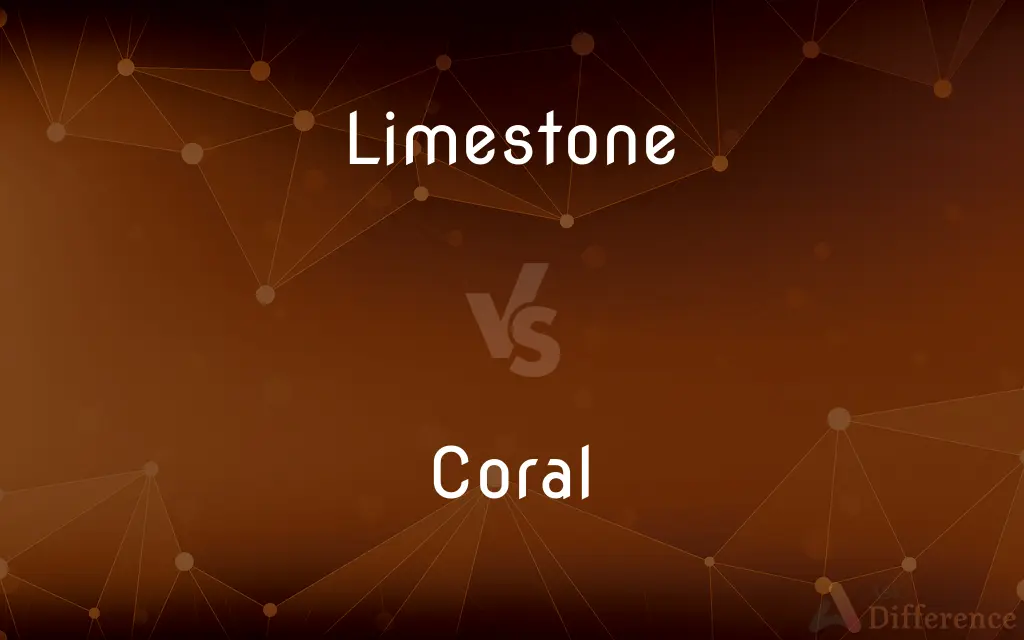Limestone vs. Coral — What's the Difference?
By Maham Liaqat & Fiza Rafique — Updated on March 19, 2024
Limestone is a sedimentary rock primarily composed of calcium carbonate, while coral is a marine organism that forms coral reefs with their calcium carbonate skeletons.

Difference Between Limestone and Coral
Table of Contents
ADVERTISEMENT
Key Differences
Limestone, a sedimentary rock, forms over centuries through the accumulation and compression of marine organism remnants, such as corals and shellfish, along with minerals. Coral, on the other hand, refers to marine invertebrates that live in compact colonies of many identical individual polyps, building extensive coral reefs primarily in shallow, warm marine waters.
The primary component of limestone is calcium carbonate, which is also what coral skeletons are made of. However, while limestone is a non-living geological formation, coral reefs are vibrant ecosystems, home to a diverse range of marine life.
Limestone is widely used in construction and manufacturing, for example, in cement production and as a building material due to its durability and abundance. Coral reefs, conversely, are protected in many parts of the world due to their ecological significance, supporting biodiversity and providing natural barriers against coastal erosion.
The formation of limestone can occur through both biological and chemical processes, including the precipitation of calcium carbonate from ocean water. Coral growth, however, is purely biological, with polyps extracting calcium ions from seawater to construct their hard skeletons.
Limestone formations can be found all over the world and span a wide range of climates and geological periods. Coral reefs are more geographically limited, found primarily in tropical and subtropical oceans where conditions are conducive to coral growth.
ADVERTISEMENT
Comparison Chart
Composition
Primarily calcium carbonate from marine organisms and minerals.
Living marine invertebrates with calcium carbonate skeletons.
Formation
Geological processes over centuries.
Biological growth of coral polyps.
Usage
Construction, manufacturing, and as a raw material in various industries.
Ecosystem services, biodiversity support, and coastal protection.
Location
Worldwide, in a variety of climates and environments.
Mostly in shallow, warm tropical and subtropical marine waters.
Ecological Role
Part of the Earth's carbon cycle and geological formations.
Critical for marine biodiversity and protecting coastlines.
Compare with Definitions
Limestone
A sedimentary rock formed over millions of years from the skeletal fragments of marine organisms.
The White Cliffs of Dover are a famous example of limestone, showcasing its geological significance.
Coral
Made up of tiny marine animals known as polyps, forming large, communal structures.
The Great Barrier Reef, composed of billions of coral polyps, is the largest coral reef system in the world.
Limestone
Widely used in construction, agriculture, and manufacturing due to its properties.
Limestone is a key ingredient in cement, an essential component of concrete.
Coral
Sensitive to environmental changes, corals serve as indicators of ocean health and climate change.
Coral bleaching, a stress response to warming ocean temperatures, highlights the impact of global climate change.
Limestone
Forms through the accumulation of calcium carbonate in marine environments.
Limestone caves and formations often feature stalactites and stalagmites, formed by mineral deposition.
Coral
Corals are foundational species, creating habitats that support diverse marine life.
Coral reefs provide shelter, food, and breeding grounds for thousands of marine species.
Limestone
Susceptible to erosion and dissolution in acidic conditions, impacting landscapes and structures.
Acid rain can erode limestone buildings and statues, gradually wearing away the stone.
Coral
Due to their ecological importance and vulnerability, corals are a significant focus of marine conservation efforts.
Protective measures include marine protected areas (MPAs) and restrictions on harmful fishing practices.
Limestone
Acts as a historical archive, containing fossils that provide insights into past life and environments.
Fossiliferous limestone contains visible fossils, offering a glimpse into ancient marine ecosystems.
Coral
Corals extract calcium from seawater to build their hard, protective skeletons.
Over time, the accumulation of coral skeletons forms the backbone of coral reefs, contributing to their complex structures.
Limestone
Limestone is a common type of carbonate sedimentary rock. It is composed mostly of the minerals calcite and aragonite, which are different crystal forms of calcium carbonate (CaCO3).
Coral
The unfertilized roe of a lobster or scallop, which is used as food and becomes reddish when cooked
We had scallops with their coral, in their fluted shells
Limestone
A common sedimentary rock consisting mostly of calcium carbonate, CaCO3, used as a building stone and in the manufacture of lime, carbon dioxide, and cement.
Coral
Corals are marine invertebrates within the class Anthozoa of the phylum Cnidaria. They typically form compact colonies of many identical individual polyps.
Limestone
An abundant rock of marine and fresh-water sediments; primarily composed of calcite (CaCO3); it occurs in a variety of forms, both crystalline and amorphous.
Coral
A hard stony substance secreted by certain marine coelenterates as an external skeleton, typically forming large reefs in warm seas
The nearby coral islands, lagoons, and atolls
A coral reef
Limestone
Pertaining to or made of limestone.
Coral
A sedentary coelenterate of warm and tropical seas, with a calcareous, horny, or soft skeleton. Most corals are colonial and many rely on the presence of green algae in their tissues to obtain energy from sunlight.
Limestone
A rock consisting chiefly of calcium carbonate or carbonate of lime. It sometimes contains also magnesium carbonate, and is then called magnesian or dolomitic limestone. Crystalline limestone is called marble.
Coral
A rocklike deposit consisting of the calcareous skeletons secreted by various marine invertebrates, chiefly anthozoans. Coral deposits often accumulate to form reefs or islands in warm seas.
Limestone
A sedimentary rock consisting mainly of calcium that was deposited by the remains of marine animals
Coral
A polyp or colony of polyps of any of the numerous anthozoans that secrete a hard or flexible skeleton, especially the reef-building hard corals.
Coral
A polyp or colony of polyps of any of various hydrozoans that secrete hard skeletons, such as the fire corals.
Coral
The hard skeleton of various corals, especially of red corals of the genus Corallium, used to make jewelry and ornaments.
Coral
An object made of this material.
Coral
A deep or strong pink to moderate red or reddish orange.
Coral
The unfertilized eggs of a female lobster, which turn a reddish color when cooked.
Coral
Of a deep or strong pink to moderate red or reddish orange.
Coral
(countable) Any of many species of marine invertebrates in the class Anthozoa, most of which build hard calcium carbonate skeletons and form colonies, or a colony belonging to one of those species.
Coral
(uncountable) A hard substance made of the skeletons of these organisms.
Coral
(countable) A somewhat yellowish orange-pink colour; the colour of red coral (Corallium rubrum) of the Mediterranean Sea, commonly used as an ornament or gem.
Coral
The ovaries of a cooked lobster; so called from their colour.
Coral
(historical) A piece of coral, usually fitted with small bells and other appurtenances, used by children as a plaything.
Coral
Made of coral.
Coral
Having the orange-pink colour of coral.
Coral
The hard parts or skeleton of various Anthozoa, and of a few Hydrozoa. Similar structures are also formed by some Bryozoa.
Coral
The ovaries of a cooked lobster; - so called from their color.
Coral
A piece of coral, usually fitted with small bells and other appurtenances, used by children as a plaything.
Coral
A variable color averaging a deep pink
Coral
The hard stony skeleton of a Mediterranean coral that has a delicate red or pink color and is used for jewelry
Coral
Unfertilized lobster roe; reddens in cooking; used as garnish or to color sauces
Coral
Marine colonial polyp characterized by a calcareous skeleton; masses in a variety of shapes often forming reefs
Coral
Of a strong pink to yellowish-pink color
Common Curiosities
What are corals?
Corals are marine invertebrates known for their symbiotic relationships and ability to form coral reefs through their calcium carbonate skeletons.
How do limestone and coral differ in their formation?
Limestone is formed through geological processes over time, while coral growth is a biological process driven by living organisms.
What is limestone?
Limestone is a sedimentary rock primarily made of calcium carbonate, often formed from the remains of marine organisms.
Can coral become limestone?
Yes, over geological timescales, coral reefs can become limestone through the accumulation and compression of coral skeletons and other marine debris.
Why is limestone important in construction?
Limestone is durable, abundant, and versatile, making it an important material in construction and manufacturing.
Are all limestone formations derived from coral reefs?
Not all limestone comes from coral reefs; it can also form from other marine organisms and through chemical precipitation of calcium carbonate.
How do conservation efforts differ for limestone and coral?
Conservation efforts for limestone focus on preserving geological and cultural heritage, while coral conservation aims to protect biodiversity and marine ecosystems.
Can limestone be found in all parts of the world?
Yes, limestone formations are found worldwide, from mountain ranges to seabeds and deserts.
Is coral harvesting legal?
Coral harvesting is heavily regulated or banned in many parts of the world due to the ecological significance of coral reefs.
What is coral bleaching, and why does it occur?
Coral bleaching is a phenomenon where corals lose their vibrant colors due to stress factors like elevated water temperatures, leading to the expulsion of symbiotic algae.
What is the ecological role of coral reefs?
Coral reefs support high biodiversity, protect coastlines from erosion, and provide resources for millions of people.
How do environmental changes affect limestone and coral?
While limestone can be affected by chemical weathering, corals are highly sensitive to environmental changes like ocean acidification and warming, which can lead to coral bleaching.
How does acid rain affect limestone and coral?
Acid rain can erode limestone structures and is harmful to coral reefs by contributing to ocean acidification.
Can limestone formations support ecosystems?
Yes, limestone formations can support diverse ecosystems, both above and below ground, such as caves that are habitats for unique species.
How are limestone and coral similar?
Both limestone and coral are primarily composed of calcium carbonate and have origins linked to marine environments and organisms.
Share Your Discovery

Previous Comparison
Auburn vs. Titian
Next Comparison
Define vs. SetAuthor Spotlight
Written by
Maham LiaqatCo-written by
Fiza RafiqueFiza Rafique is a skilled content writer at AskDifference.com, where she meticulously refines and enhances written pieces. Drawing from her vast editorial expertise, Fiza ensures clarity, accuracy, and precision in every article. Passionate about language, she continually seeks to elevate the quality of content for readers worldwide.














































